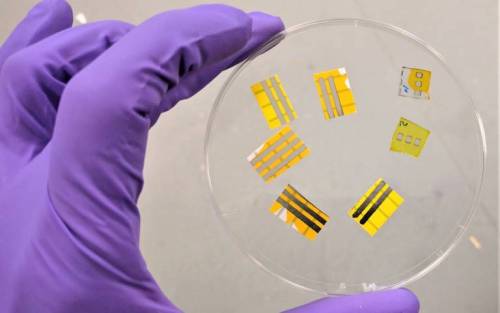
In the future, tattoos might not only be decorative — they could be tools for health care, sports, and more. Scientists recently developed a light-emitting, transferable tattoo that can be attached to the skin and could be used to display information.
The concept of smart tattoos has been around for a while, but this is the first time a light-emitting version has been created. It uses organic light-emitting diodes (OLEDs), the same technology that is used in high-end TVs, which are printed onto temporary tattoo paper. The tattoo can then be applied by being put on the skin and dabbed with water — and it’s easily removable as well.
The scientists who developed the tattoo at University College London and the Italian Institute of Technology said they could see a number of uses for the technology, both for fun and for important health care reasons.
“The tattooable OLEDs that we have demonstrated for the first time can be made at scale and very cheaply,” said author Franco Cacialli in a statement. “They can be combined with other forms of tattoo electronics for a very wide range of possible uses. These could be for fashion – for instance, providing glowing tattoos and light-emitting fingernails.
“In sports, they could be combined with a sweat sensor to signal dehydration. In health care, they could emit light when there is a change in a patient’s condition — or, if the tattoo was turned the other way into the skin, they could potentially be combined with light-sensitive therapies to target cancer cells, for instance.”
The devices aren’t only useful for humans though. The researchers tested applying them to glass, plastic, and even fruit. Similar devices could be attached to food packaging or fresh fruit to warn when food is past its expiration date.
The technology has a great deal of potential because it is cheap to make and easy to apply, and can be removed by washing with soap and water. The researchers say their next step is to work out how to integrate a battery and to make the devices more durable.
“Our proof-of-concept study is the first step,” Cacialli said. “Future challenges will include encapsulating the OLEDs as much as possible to stop them from degrading quickly through contact with air, as well as integrating the device with a battery or supercapacitor.”
Editors' Recommendations
- Tattooing could be pain-free thanks to new needle tech
- Next-generation batteries could use material derived from trees
- AppleCare fraud scheme used more than 1,000 fake iPhones from Hong Kong
- Microsoft wants to use A.I. to make health care better for everyone
- All Sony TVs at CES 2020: 8K LED, OLED, and more